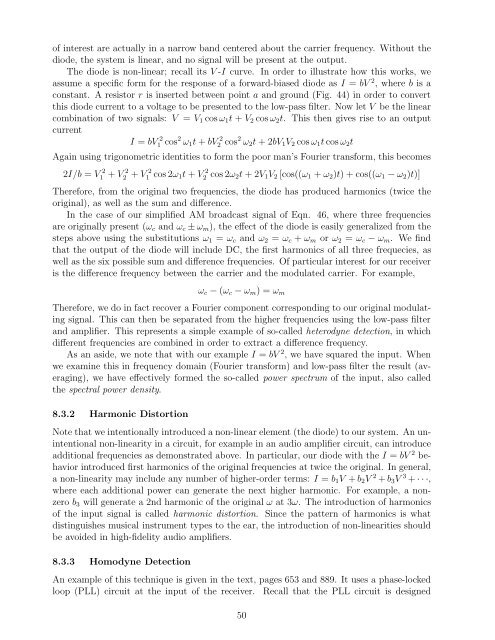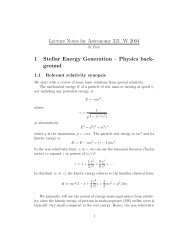Lecture Notes for Analog Electronics - The Electronic Universe ...
Lecture Notes for Analog Electronics - The Electronic Universe ...
Lecture Notes for Analog Electronics - The Electronic Universe ...
You also want an ePaper? Increase the reach of your titles
YUMPU automatically turns print PDFs into web optimized ePapers that Google loves.
of interest are actually in a narrow band centered about the carrier frequency. Without the<br />
diode, the system is linear, and no signal will be present at the output.<br />
<strong>The</strong> diode is non-linear; recall its V -I curve. In order to illustrate how this works, we<br />
assume a specific <strong>for</strong>m <strong>for</strong> the response of a <strong>for</strong>ward-biased diode as I = bV 2 ,wherebis a<br />
constant. A resistor r is inserted between point a and ground (Fig. 44) in order to convert<br />
this diode current to a voltage to be presented to the low-pass filter. Now let V be the linear<br />
combination of two signals: V = V1 cos ω1t + V2 cos ω2t. This then gives rise to an output<br />
current<br />
I = bV 2<br />
1 cos 2 ω1t + bV 2<br />
2 cos 2 ω2t +2bV1V2 cos ω1t cos ω2t<br />
Again using trigonometric identities to <strong>for</strong>m the poor man’s Fourier trans<strong>for</strong>m, this becomes<br />
2I/b = V 2<br />
1<br />
+ V 2<br />
2<br />
+ V 2<br />
1 cos 2ω1t + V 2<br />
2 cos 2ω2t +2V1V2[cos((ω1 + ω2)t)+cos((ω1−ω2)t)]<br />
<strong>The</strong>re<strong>for</strong>e, from the original two frequencies, the diode has produced harmonics (twice the<br />
original), as well as the sum and difference.<br />
In the case of our simplified AM broadcast signal of Eqn. 46, where three frequencies<br />
are originally present (ωc and ωc ± ωm), the effect of the diode is easily generalized from the<br />
steps above using the substitutions ω1 = ωc and ω2 = ωc + ωm or ω2 = ωc − ωm. We find<br />
that the output of the diode will include DC, the first harmonics of all three frequecies, as<br />
well as the six possible sum and difference frequencies. Of particular interest <strong>for</strong> our receiver<br />
is the difference frequency between the carrier and the modulated carrier. For example,<br />
ωc − (ωc − ωm) =ωm<br />
<strong>The</strong>re<strong>for</strong>e, we do in fact recover a Fourier component corresponding to our original modulating<br />
signal. This can then be separated from the higher frequencies using the low-pass filter<br />
and amplifier. This represents a simple example of so-called heterodyne detection, inwhich<br />
different frequencies are combined in order to extract a difference frequency.<br />
As an aside, we note that with our example I = bV 2 , we have squared the input. When<br />
we examine this in frequency domain (Fourier trans<strong>for</strong>m) and low-pass filter the result (averaging),<br />
we have effectively <strong>for</strong>med the so-called power spectrum of the input, also called<br />
the spectral power density.<br />
8.3.2 Harmonic Distortion<br />
Note that we intentionally introduced a non-linear element (the diode) to our system. An unintentional<br />
non-linearity in a circuit, <strong>for</strong> example in an audio amplifier circuit, can introduce<br />
additional frequencies as demonstrated above. In particular, our diode with the I = bV 2 behavior<br />
introduced first harmonics of the original frequencies at twice the original. In general,<br />
a non-linearity may include any number of higher-order terms: I = b1V + b2V 2 + b3V 3 + ···,<br />
where each additional power can generate the next higher harmonic. For example, a nonzero<br />
b3 will generate a 2nd harmonic of the original ω at 3ω. <strong>The</strong> introduction of harmonics<br />
of the input signal is called harmonic distortion. Since the pattern of harmonics is what<br />
distinguishes musical instrument types to the ear, the introduction of non-linearities should<br />
be avoided in high-fidelity audio amplifiers.<br />
8.3.3 Homodyne Detection<br />
An example of this technique is given in the text, pages 653 and 889. It uses a phase-locked<br />
loop (PLL) circuit at the input of the receiver. Recall that the PLL circuit is designed<br />
50













